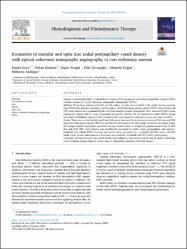Evaluation of macular and optic disc radial peripapillary vessel density with optical coherence tomography angiography in iron deficiency anemia

View/
Access
info:eu-repo/semantics/embargoedAccessDate
03.02.2022Metadata
Show full item recordCitation
Koca, S., Bozkurt, E., Eroğul, Ö., Yavaşoğlu, F., Doğan, M., & Akdoğan, M. (2022). Evaluation of macular and optic disc radial peripapillary vessel density with optical coherence tomography angiography in iron deficiency anemia. Photodiagnosis and Photodynamic Therapy, 38, 102744.Abstract
Purpose: To investigate effect of iron deficiency anemia (IDA) on macular and radial peripapillary capillary (RPC) vascular changes by optical coherence tomography angiography (OCTA).
Methods: Thirty-three patients with IDA and 33 healthy controls were enrolled in the study. Foveal avascular zone (FAZ) area, macular superficial capillary plexus (SCP) and deep capillary plexus (DCP) vessel density and RPC vessel density were evaluated by the AngioVue Imaging System. Hemoglobin (Hb), hematocrit (Hct), mean corpuscular volume (MCV), mean corpuscular hemoglobin (MCH), red cell distribution width (RDW), serum iron, total iron-binding capacity (TIBC), serum ferritin and transferrin saturation values were also recorded.
Results: There were no statistically significant differences between the two groups in terms of FAZ area and FAZ perimeter while foveal density (FD) was significantly decreased in the IDA group. Compared to control group, IDA group revealed significantly decreased macular vessel density in all macular regions except fovea in both SCP and DCP. RPC vessel density was significantly decreased in whole image, peripapillary and superior-hemifield area wihout RNFL thinning. Hemoglobin level was positively correlated with SCP whole and RPC whole vessel density and serum iron level was also positively correlated with SCP whole vessel density.
Conclusion: Macular and optic disc vessel density were reduced in IDA patients. OCTA may be useful in detecting retinal ischemia before clinically visible signs of retinopathy associated with IDA appear.















